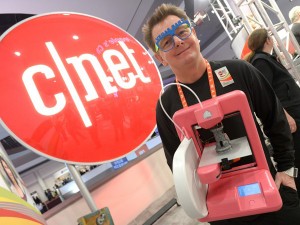CES stage set for new wave of gadgets

Scott Turner of 3-D Systems Corp. and his 3-D printer wait to participate in C/NET’s show during the 2013 International CES at the Las Vegas Convention Center on January 10, 2013 in Las Vegas, Nevada. AFP FILE PHOTO
LAS VEGAS – As spending on gadgets flattens in a world obsessed with smartphones and tablets, the Consumer Electronics Show here hopes to be a launch pad for a new must-have device.
From drones and smart cars to remote-controlled door locks and eyewear, the annual CES event officially starting Tuesday promises to showcase an “Internet of Things” with users at its heart.
The technology extravaganza that plays out each year in the glitz-laden city of Las Vegas has evolved beyond the eye-popping television technology for which it is known, to serve as a stage for once-dumb devices given brains in the form of computer chips and Internet connections.
“You will see two types of technology here,” Shawn DuBravac, chief economist at the Consumer Electronics Association which puts on the international show, said Sunday.
“You will see the technologically feasible and the ones that are commercially viable.”
Innovations on display but not prime for market will include bendable screens.
Potentially disruptive technology that is available includes 3D printers that let users print objects in a fashion similar to printing documents.
“It is still a very nascent market, but we are starting to see it grow,” DuBravac said.
The CES stage is typically a prime showcase for gizmos that don’t usually get a spotlight.
“You will see a lot about the Internet of things; all the gadgets that are not a tablet, smartphone or personal computer but are attached to the Internet,” said Forrester analyst Frank Gillett.
“Like your car telling you that you are speeding too much or door locks that you unlock with a smartphone. There are all kinds of gadgety things like that we will see.”
A driver of the hot CES trend of wearable computers such as bracelets or pendants that track wearers’ activities or health is proliferation of low-cost sensors.
Sensors in cars help drivers park or enable cruise-control features to modify speed depending on traffic, while Internet-linked thermostats in homes can sense when residents’ smartphones are nearing and adjust temperatures to welcome them.
And door locks with wireless connectivity and sensors can open automatically for people arriving home, or be controlled remotely using smartphones.
As a result, protecting personal information gathered by sensors is “certainly on the radar for all manufacturers at CES,” according to DuBravac.
“I almost wonder sometimes if privacy is an anomaly instead of the other way around,” DuBravac said, noting that in small towns of days gone by everyone seemed to know everyone else’s doings.
“If I can get a richer experience by sharing my data, that is a fair trade-off,” he suggested.
The latest in television ultra-high definition screens will be on display, but analysts expected them to land in the market with a thud similar to that made by 3-D televisions.
“Your television gets a zillion more pixels, but most people won’t be able to notice the difference,” Gillett said, though DuBravac expects scores of Ultra HD television announcements at CES.
UItra HD television stands to benefit from availability of rich content at online venues such as Netflix, YouTube as well as from major film studios.
They are also hitting the market about eight years after consumers upgraded en masse to high definition screens, and historic buying patterns indicate people will be looking for replacement TVs.
The global market for technology hit a record high of $1.068 trillion in 2013 powered by uptake in smartphones and tablets, according to Steve Koenig, director of industry analysis at the Consumer Electronics Association.
He forecast that figure would ebb slightly this year and level off at $1.055 trillion, noting that regions where demand for smartphones or tablets is hottest tend to be places where low prices are needed to penetrate markets.
“North America is no longer in the lead in terms of technology spending,” Koenig said.
“The spending coming on line in Asia has sealed the deal in terms of leadership and America will have to settle for number two. Simply put, there is strength in numbers in China.”
Amazingly, 43 cents of every dollar spent on consumer electronics this year was predicted to go on smartphones and tablets.
“We are now awaiting that next wave of innovation, and that is really what CES is all about,” Koenig added.